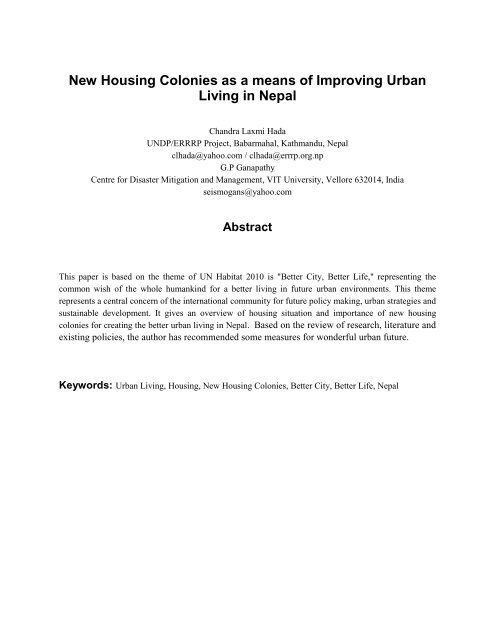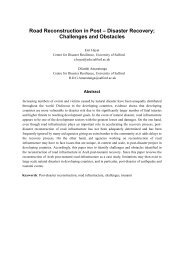New Housing Colonies as a means of Improving Urban Living in ...
New Housing Colonies as a means of Improving Urban Living in ...
New Housing Colonies as a means of Improving Urban Living in ...
Create successful ePaper yourself
Turn your PDF publications into a flip-book with our unique Google optimized e-Paper software.
<strong>New</strong> <strong>Hous<strong>in</strong>g</strong> <strong>Colonies</strong> <strong>as</strong> a <strong>means</strong> <strong>of</strong> <strong>Improv<strong>in</strong>g</strong> <strong>Urban</strong><br />
<strong>Liv<strong>in</strong>g</strong> <strong>in</strong> Nepal<br />
Chandra Laxmi Hada<br />
UNDP/ERRRP Project, Babarmahal, Kathmandu, Nepal<br />
clhada@yahoo.com / clhada@errrp.org.np<br />
G.P Ganapathy<br />
Centre for Dis<strong>as</strong>ter Mitigation and Management, VIT University, Vellore 632014, India<br />
seismogans@yahoo.com<br />
Abstract<br />
This paper is b<strong>as</strong>ed on the theme <strong>of</strong> UN Habitat 2010 is "Better City, Better Life," represent<strong>in</strong>g the<br />
common wish <strong>of</strong> the whole humank<strong>in</strong>d for a better liv<strong>in</strong>g <strong>in</strong> future urban environments. This theme<br />
represents a central concern <strong>of</strong> the <strong>in</strong>ternational community for future policy mak<strong>in</strong>g, urban strategies and<br />
susta<strong>in</strong>able development. It gives an overview <strong>of</strong> hous<strong>in</strong>g situation and importance <strong>of</strong> new hous<strong>in</strong>g<br />
colonies for creat<strong>in</strong>g the better urban liv<strong>in</strong>g <strong>in</strong> Nepal. B<strong>as</strong>ed on the review <strong>of</strong> research, literature and<br />
exist<strong>in</strong>g policies, the author h<strong>as</strong> recommended some me<strong>as</strong>ures for wonderful urban future.<br />
Keywords: <strong>Urban</strong> <strong>Liv<strong>in</strong>g</strong>, <strong>Hous<strong>in</strong>g</strong>, <strong>New</strong> <strong>Hous<strong>in</strong>g</strong> <strong>Colonies</strong>, Better City, Better Life, Nepal
1. Background<br />
<strong>Hous<strong>in</strong>g</strong> refers to a dwell<strong>in</strong>g or a hous<strong>in</strong>g unit. It is said that the well be<strong>in</strong>g <strong>of</strong> the population <strong>in</strong> general<br />
depends on the quantity and quality <strong>of</strong> hous<strong>in</strong>g available. The right to hous<strong>in</strong>g h<strong>as</strong> been recognized <strong>in</strong><br />
various declarations: Article 25 <strong>of</strong> the Universal Declaration <strong>of</strong> Human Rights states that “Everyone h<strong>as</strong><br />
the right to a standard <strong>of</strong> liv<strong>in</strong>g adequate for the health and well-be<strong>in</strong>g <strong>of</strong> himself and <strong>of</strong> his family,<br />
<strong>in</strong>clud<strong>in</strong>g food, cloth<strong>in</strong>g, shelter …” <strong>Hous<strong>in</strong>g</strong> is one <strong>of</strong> the key <strong>in</strong>dicators <strong>of</strong> urban growth and economy<br />
<strong>of</strong> a particular city.<br />
In 1800, 2% <strong>of</strong> the global population lived <strong>in</strong> cities. In 1950, the figure raised to 29%, <strong>in</strong> 2000, almost<br />
half the world population moved <strong>in</strong>to cities, and by 2010, <strong>as</strong> estimated by the United Nations, the urban<br />
population will account for 55% <strong>of</strong> the total human population. The 21st Century will be known <strong>as</strong> the<br />
century <strong>of</strong> the city - a moment <strong>in</strong> history when one human be<strong>in</strong>g tipped the scales to make the global<br />
population predom<strong>in</strong>antly urban. Dur<strong>in</strong>g this century megacities will cont<strong>in</strong>ue to grow and m<strong>as</strong>sive<br />
conurbations <strong>of</strong> more than 20 million people, known <strong>as</strong> meta-cities, will emerge. Simultaneously, the<br />
majority <strong>of</strong> the world’s urban population will cont<strong>in</strong>ue to live <strong>in</strong> small cities with less than 500,000<br />
<strong>in</strong>habitants and <strong>in</strong>termediate cities with between 1 and 5 million <strong>in</strong>habitants. Better city is responsive to<br />
the needs and <strong>as</strong>pirations <strong>of</strong> its residents. It <strong>of</strong>fers accessible, affordable hous<strong>in</strong>g, quality education and<br />
healthcare systems, susta<strong>in</strong>able, <strong>in</strong>novative and safe transport for all. It creates conditions to provide<br />
adequate hous<strong>in</strong>g and b<strong>as</strong>ic services and strives to improve the hous<strong>in</strong>g conditions <strong>of</strong> the urban poor. A<br />
city with better quality <strong>of</strong> life creates a safe environment that protects its residents from accidents and<br />
different forms <strong>of</strong> crime and violence.<br />
The need <strong>of</strong> the urban hous<strong>in</strong>g colonies is <strong>in</strong>cre<strong>as</strong><strong>in</strong>g with the p<strong>as</strong>sage <strong>of</strong> time with f<strong>as</strong>ter pace <strong>of</strong><br />
urbanization underway <strong>in</strong> the country. <strong>Hous<strong>in</strong>g</strong> is b<strong>as</strong>ic human need for civilized liv<strong>in</strong>g but it h<strong>as</strong><br />
become one <strong>of</strong> the complex problems for the low-<strong>in</strong>come urban dwellers even to afford a modest house<br />
<strong>in</strong> Nepal. The problem <strong>in</strong> many develop<strong>in</strong>g and even <strong>in</strong> some developed countries is not that hous<strong>in</strong>g is<br />
too expensive, but that <strong>in</strong>comes are too low. Ris<strong>in</strong>g land and house prices is also a concern fac<strong>in</strong>g most<br />
world cities and the ability to ma<strong>in</strong>ta<strong>in</strong> affordable and high-quality places to live is an important issue. To<br />
fulfill the demand for hous<strong>in</strong>g, government, f<strong>in</strong>ancial <strong>in</strong>stitution and private sector have started organized<br />
hous<strong>in</strong>g and related activities <strong>in</strong> Nepal. This is necessary because only the organized hous<strong>in</strong>g can solve<br />
the urban hous<strong>in</strong>g problems. The owner built hous<strong>in</strong>g is not go<strong>in</strong>g to solve it <strong>as</strong> h<strong>as</strong> been seen at the<br />
present.<br />
In this context there are series <strong>of</strong> constra<strong>in</strong>ts that the urban area is fac<strong>in</strong>g at the moment. These are the<br />
lack <strong>of</strong> f<strong>in</strong>ance, unavailability <strong>of</strong> the serviced land plots, the lack <strong>of</strong> optimally efficient build<strong>in</strong>g materials<br />
and construction technology, the lack <strong>of</strong> suitable legislation about rental hous<strong>in</strong>g and provid<strong>in</strong>g hous<strong>in</strong>g<br />
to the poor people, the need to upgrade the dilapidated hous<strong>in</strong>g stock, lack <strong>of</strong> hous<strong>in</strong>g for disadvantaged<br />
groups such <strong>as</strong> the old, the orphans and the street children and above all the lack <strong>of</strong> recent data <strong>in</strong><br />
hous<strong>in</strong>g.
2. <strong>Hous<strong>in</strong>g</strong> Situation <strong>in</strong> Nepal<br />
In Nepal, hous<strong>in</strong>g occupants are broadly categorized <strong>in</strong>to owner, renter, rent-free and others. N<strong>in</strong>ety Two<br />
percent <strong>of</strong> the households reside <strong>in</strong> their own hous<strong>in</strong>g units, 5 percent are renters (pay rent) and 2 percent<br />
live on rent-free hous<strong>in</strong>g units. Not surpris<strong>in</strong>gly, 24 percent <strong>of</strong> households <strong>in</strong> urban are<strong>as</strong> pay rent and the<br />
proportion is 33 percent <strong>in</strong> the Kathmandu valley urban are<strong>as</strong> alone. (NLSS, 2004). Average size <strong>of</strong><br />
dwell<strong>in</strong>g decl<strong>in</strong>ed from 604 to 531 square feet dur<strong>in</strong>g the same period. The proportion <strong>of</strong> households<br />
occupy<strong>in</strong>g hous<strong>in</strong>g units with cement-bonded outer walls, concrete or galvanized sheet ro<strong>of</strong>, and<br />
cemented/tiled floor have all <strong>in</strong>cre<strong>as</strong>ed between these two periods. Similarly, household's access to<br />
electricity and piped water h<strong>as</strong> <strong>in</strong>cre<strong>as</strong>ed from 14 to 37 percent and from 33 to 44 percent respectively.<br />
Almost 39 percent <strong>of</strong> households now have toilet facility <strong>in</strong> their own dwell<strong>in</strong>gs, compared to 22 percent<br />
<strong>in</strong> 1995/96. Accord<strong>in</strong>g to the census <strong>of</strong> 2001, about 14 percent <strong>of</strong> the population <strong>in</strong> Nepal is resid<strong>in</strong>g <strong>in</strong><br />
urban are<strong>as</strong>, and this figure is estimated to reach to 24 percent <strong>in</strong> the next 10 years. Not surpris<strong>in</strong>gly, 24<br />
percent <strong>of</strong> households <strong>in</strong> urban are<strong>as</strong> pay rent and the proportion is 33 percent <strong>in</strong> the Kathmandu valley<br />
urban are<strong>as</strong> alone. (NLSS, 2004).<br />
<strong>Hous<strong>in</strong>g</strong> is a b<strong>as</strong>ic need which people fulfill through formal or <strong>in</strong>formal <strong>means</strong>. With more than 1.5<br />
million people, (220,000 households) the Kathmandu Valley is the urban center <strong>of</strong> Nepal. One-third <strong>of</strong> its<br />
residents live <strong>in</strong> slum dwell<strong>in</strong>gs and 18,000 people are squatt<strong>in</strong>g (without land rights). (KVTDC, 2005).<br />
With respect to the occupancy status <strong>of</strong> the households, the condition <strong>of</strong> the population <strong>in</strong> Nepal seems<br />
satisfactory; the hous<strong>in</strong>g affordability is high. But it is a pity that the quality <strong>of</strong> the majority <strong>of</strong> these<br />
hous<strong>in</strong>g units is not satisfactory. For people from all <strong>in</strong>come groups - but especially for the poor -<br />
hous<strong>in</strong>g is not a product, but a process. It’s not someth<strong>in</strong>g that is completed all at one time accord<strong>in</strong>g to a<br />
plan, but is developed <strong>in</strong> stages, <strong>as</strong> a household’s needs and resources change. The grow<strong>in</strong>g urban<br />
population is spurr<strong>in</strong>g governments to reth<strong>in</strong>k their strategies on hous<strong>in</strong>g related activities. Public sector<br />
hous<strong>in</strong>g is almost unknown <strong>in</strong> Nepal <strong>as</strong> hous<strong>in</strong>g is considered an <strong>in</strong>dividual responsibility.<br />
Like any other major cities <strong>in</strong> the world, Kathmandu valley h<strong>as</strong> its own challenges, such <strong>as</strong> rapid<br />
urbanization process and haphazard development, which have put pressure on the city's natural resources<br />
and physical space. The city's rapidly grow<strong>in</strong>g population is also stretch<strong>in</strong>g its <strong>in</strong>fr<strong>as</strong>tructure to its limit.<br />
Water shortage, lack <strong>of</strong> proper w<strong>as</strong>te management and traffic congestion, among others, have made life<br />
difficult here. Grow<strong>in</strong>g squatter settlements, overcrowded hous<strong>in</strong>g condition and ever grow<strong>in</strong>g homeless<br />
population <strong>in</strong>dicate the severity <strong>of</strong> problems <strong>in</strong> urban Nepal. Especially <strong>in</strong> the Kathmandu valley, not<br />
only for the poor, but also for many middle cl<strong>as</strong>s households, hous<strong>in</strong>g h<strong>as</strong> become unaffordable.<br />
3. <strong>New</strong> <strong>Hous<strong>in</strong>g</strong> <strong>Colonies</strong><br />
The concept <strong>of</strong> real estate and hous<strong>in</strong>g came to Kathmandu around 1990 but it took almost a decade to<br />
catch on. Kathmandu Residency is the first to move towards establish<strong>in</strong>g susta<strong>in</strong>able real estate <strong>in</strong>dustry<br />
from Ansal Chaudhary Company. With the enactment <strong>of</strong> Apartment Ownership Act <strong>in</strong> 1997, legal
framework for development, sale and management h<strong>as</strong> been established. This act h<strong>as</strong> been <strong>in</strong>strumental<br />
<strong>in</strong> <strong>in</strong>itiat<strong>in</strong>g a formal hous<strong>in</strong>g market <strong>in</strong> Nepal where developers, design consultants, contractors and<br />
bankers have their own role to play. The bankers have found a new avenue for <strong>in</strong>vestment (both for<br />
builders and prospective buyers). Similarly designers have found hous<strong>in</strong>g <strong>as</strong> a reliable job and an<br />
opportunity to express their creativity and <strong>in</strong>novation. <strong>Hous<strong>in</strong>g</strong> developers have emerged <strong>as</strong> the champion<br />
<strong>in</strong> the market because <strong>of</strong> their skill <strong>in</strong> br<strong>in</strong>g<strong>in</strong>g together all the above-mentioned parties <strong>in</strong> achiev<strong>in</strong>g their<br />
goal. <strong>Hous<strong>in</strong>g</strong> developers have been successful <strong>in</strong> creat<strong>in</strong>g a new k<strong>in</strong>d <strong>of</strong> bus<strong>in</strong>ess entrepreneurship <strong>in</strong> the<br />
country that can guide planned urban development by the private sector. Investors are f<strong>in</strong>d<strong>in</strong>g hous<strong>in</strong>g <strong>as</strong><br />
an attractive area for <strong>in</strong>vestment because <strong>of</strong> its expand<strong>in</strong>g market and lucrative return.<br />
Prior to that, the busy people <strong>of</strong> the city would plan for almost five years to build their own houses. The<br />
hous<strong>in</strong>g <strong>in</strong>dustry spared them from the burden <strong>of</strong> long and arduous t<strong>as</strong>k <strong>of</strong> f<strong>in</strong>d<strong>in</strong>g a location for<br />
construct<strong>in</strong>g a build<strong>in</strong>g, collect<strong>in</strong>g materials and so on and so forth. In the Kathmandu Valley,<br />
government could only cater less than 10% <strong>of</strong> the demand <strong>of</strong> the hous<strong>in</strong>g plots. But these are far from<br />
adequate. As many <strong>as</strong> 72 private group hous<strong>in</strong>g projects have emerged to supply the readymade hous<strong>in</strong>g<br />
<strong>in</strong> Kathmandu valley (KVTDC, 2009).<br />
So far the Kathmandu Valley Town Development Implementation Committee (KVTDIC), Lalitpur had<br />
approved total dwell<strong>in</strong>g units <strong>of</strong> 11 group hous<strong>in</strong>g project contributes 877 numbers and the 12 apartment<br />
project contributes 1128 dwell<strong>in</strong>g units constitut<strong>in</strong>g 2005 numbers <strong>in</strong> Lalitpur district. Where<strong>as</strong> <strong>in</strong><br />
Kathmandu, the total dwell<strong>in</strong>g units <strong>of</strong> 10 group hous<strong>in</strong>g project contributes 626 numbers and the 32<br />
apartment project contributes 1838 dwell<strong>in</strong>g units constitut<strong>in</strong>g 2954 numbers <strong>in</strong> Kathmandu District. The<br />
Bhaktapur district is on the process <strong>of</strong> approv<strong>in</strong>g 1 group hous<strong>in</strong>g project only. These data are from the<br />
Kathmandu Valley Town Development Committee, Kathmandu Valley Town Development<br />
Implementation Committee, Lalitpur and Bhaktapur Town Development Committee.<br />
Table 1: <strong>Hous<strong>in</strong>g</strong> Projects approved by KVTDIC (Source: KVTDIC, DUDBC, March 2009)<br />
Location<br />
Lalitpur District<br />
Kathmandu District<br />
Name <strong>of</strong> project<br />
No. <strong>of</strong> No. <strong>of</strong> Dwell<strong>in</strong>g<br />
Project Units<br />
Group <strong>Hous<strong>in</strong>g</strong> Project 11 877<br />
Apartment <strong>Hous<strong>in</strong>g</strong><br />
Project<br />
12 1128<br />
Group <strong>Hous<strong>in</strong>g</strong> Project 10 626<br />
Apartment <strong>Hous<strong>in</strong>g</strong><br />
Project<br />
32 1838<br />
Bhaktapur District Group <strong>Hous<strong>in</strong>g</strong> Project 1<br />
Kathmandu and Lalitpur<br />
already constructed before<br />
com<strong>in</strong>g Apartment Act<br />
2054: Not necessary to take<br />
Permit.<br />
Group <strong>Hous<strong>in</strong>g</strong> Projects<br />
and Apartments<br />
6 573<br />
Total<br />
5042 Dwell<strong>in</strong>g<br />
Units
The total <strong>of</strong> 5042 number <strong>of</strong> dwell<strong>in</strong>g units h<strong>as</strong> been permitted formally for the organized private hous<strong>in</strong>g<br />
projects to the hous<strong>in</strong>g developers through KVTDC.<br />
Photographs <strong>of</strong> Organized <strong>Hous<strong>in</strong>g</strong> <strong>Colonies</strong> <strong>in</strong> Kathmandu Valley<br />
Figure 1: The Comfort <strong>Hous<strong>in</strong>g</strong>, Sitapaila,<br />
Kathmandu<br />
Figure 2: The Sunrise Homes, Balkumari, Lalitpur<br />
4. <strong>New</strong> <strong>Hous<strong>in</strong>g</strong> <strong>Colonies</strong> for Better <strong>Urban</strong> <strong>Liv<strong>in</strong>g</strong><br />
The development <strong>of</strong> new hous<strong>in</strong>g colonies h<strong>as</strong> been quite encourag<strong>in</strong>g <strong>as</strong> part <strong>of</strong> planned urbanization.<br />
With the availability <strong>of</strong> hous<strong>in</strong>g f<strong>in</strong>ance from banks and f<strong>in</strong>ancial <strong>in</strong>stitutions, hous<strong>in</strong>g development <strong>in</strong><br />
Nepal h<strong>as</strong> been transform<strong>in</strong>g from owner-built system to organized hous<strong>in</strong>g development. <strong>Hous<strong>in</strong>g</strong> <strong>in</strong><br />
major cities <strong>of</strong> Nepal is now be<strong>in</strong>g considered <strong>as</strong> a commodity rather than a social <strong>as</strong>set.<br />
For example a survey conducted <strong>in</strong> the hous<strong>in</strong>g project (Household), especially four hous<strong>in</strong>g projects are<br />
taken <strong>in</strong>to consideration namely: Civil Homes Ph<strong>as</strong>e I, Ph<strong>as</strong>e II, Sunrise Homes, and The Comfort<br />
<strong>Hous<strong>in</strong>g</strong>. The price <strong>of</strong> houses and apartments varies b<strong>as</strong>ed on the hous<strong>in</strong>g company and its facilities and<br />
location. The number <strong>of</strong> household liv<strong>in</strong>g <strong>in</strong> the dwell<strong>in</strong>g unit is mostly <strong>of</strong> nuclear family. The <strong>in</strong>come<br />
range <strong>of</strong> each household varies from NRs. 10, 1000 to 350, 000 per month. The current cost <strong>of</strong> dwell<strong>in</strong>g<br />
units <strong>in</strong> organized hous<strong>in</strong>g projects varies from 32 lakhs to 200 lakhs <strong>in</strong> Kathmandu valley. Till so far<br />
most hous<strong>in</strong>g developers are cater<strong>in</strong>g only the very high <strong>in</strong>come group, high <strong>in</strong>come group, and middle<br />
high <strong>in</strong>come group except few for middle <strong>in</strong>come group and low <strong>in</strong>come group <strong>of</strong> people.<br />
The hous<strong>in</strong>g colonies h<strong>as</strong> been gradually pickl<strong>in</strong>g up <strong>in</strong> Kathmandu due to <strong>in</strong>cre<strong>as</strong><strong>in</strong>g trend among people<br />
to live <strong>in</strong> high standard colonies. So it certa<strong>in</strong>ly <strong>in</strong>dicates that people are mov<strong>in</strong>g towards <strong>in</strong>formal
hous<strong>in</strong>g to formal hous<strong>in</strong>g. Regard<strong>in</strong>g the quality <strong>of</strong> dwell<strong>in</strong>g units most <strong>of</strong> the hous<strong>in</strong>g colonies are made<br />
up <strong>of</strong> the frame structures. The demand for hous<strong>in</strong>g - both separate and apartment - h<strong>as</strong> been <strong>in</strong>cre<strong>as</strong><strong>in</strong>g <strong>in</strong><br />
the country because people liv<strong>in</strong>g <strong>in</strong> them can avail <strong>of</strong> various many facilities. The hous<strong>in</strong>g companies<br />
have been provid<strong>in</strong>g many facilities <strong>in</strong>clud<strong>in</strong>g security, supply <strong>of</strong> dr<strong>in</strong>k<strong>in</strong>g water, electricity backup,<br />
garden, children playground, physical fitness, elevators, ATM service, swimm<strong>in</strong>g pool, common space,<br />
and others. The users are mostly satisfied with the built environment, better liv<strong>in</strong>g condition, community<br />
liv<strong>in</strong>g and good security <strong>in</strong> new hous<strong>in</strong>g colonies. Apart from that dwell<strong>in</strong>g units can now be bought, sold<br />
and rented out. The new hous<strong>in</strong>g colonies have more common space than private one which seems like<br />
follow<strong>in</strong>g Malla period <strong>of</strong> construct<strong>in</strong>g courtyard system houses. As we all know that hous<strong>in</strong>g covers<br />
mostly 60% <strong>of</strong> land use and the importance <strong>of</strong> new hous<strong>in</strong>g colonies <strong>in</strong> develop<strong>in</strong>g physical, social and<br />
cultural level stands highly significant for better urban liv<strong>in</strong>g environment.<br />
5. Conclusions<br />
The quest for a better life h<strong>as</strong> run through the urban history <strong>of</strong> mank<strong>in</strong>d. Own<strong>in</strong>g a house is everyman’s<br />
dream and his prestige attached to it. In today’s f<strong>as</strong>t paced life, spend<strong>in</strong>g time and effort towards build<strong>in</strong>g<br />
a house is someth<strong>in</strong>g that very few can afford. The sad fact is that the formal hous<strong>in</strong>g systems, <strong>as</strong> they<br />
exist today <strong>in</strong> most cities, have been unable to reach the majority <strong>of</strong> the urban populations <strong>in</strong> Nepal. The<br />
prospects <strong>of</strong> hous<strong>in</strong>g sector is very bright because <strong>of</strong> an <strong>in</strong>cre<strong>as</strong><strong>in</strong>g urban population, limited land,<br />
availability <strong>of</strong> hous<strong>in</strong>g loan from different bank<strong>in</strong>g <strong>in</strong>stitutions that h<strong>as</strong> put new homes with<strong>in</strong> the reach<br />
<strong>of</strong> more customers. The <strong>Hous<strong>in</strong>g</strong> developers <strong>of</strong> Nepal have been provid<strong>in</strong>g quality hous<strong>in</strong>g but they have<br />
been cater<strong>in</strong>g to the need <strong>of</strong> upper cl<strong>as</strong>ses only. Options to afford hous<strong>in</strong>g are needed that can meet the<br />
scale required <strong>in</strong> the context <strong>of</strong> rapid urbanization. Furthermore, the right k<strong>in</strong>d <strong>of</strong> desirable process is<br />
needed <strong>in</strong> which all group <strong>of</strong> people are the center <strong>in</strong> achiev<strong>in</strong>g large scale hous<strong>in</strong>g development br<strong>in</strong>g<br />
about significant change and development <strong>in</strong> urban poverty issues, improvement <strong>of</strong> quality <strong>of</strong> life and<br />
human equality. It can also directly affect better governance and management <strong>of</strong> the city <strong>as</strong> a whole. So<br />
this is an excit<strong>in</strong>g time <strong>in</strong> urban hous<strong>in</strong>g development <strong>as</strong> the 21st Century will be known <strong>as</strong> the century <strong>of</strong><br />
the city. So, the public and private agencies have to jo<strong>in</strong> hand with the Government to make the<br />
realization <strong>of</strong> the urban hous<strong>in</strong>g needs for a wonderful urban future, <strong>of</strong> Better Cities, Better Life, a<br />
reality.<br />
References<br />
Hada, Chandra Laxmi, 2008, Thesis Report for F<strong>in</strong>anc<strong>in</strong>g <strong>of</strong> <strong>Urban</strong> <strong>Hous<strong>in</strong>g</strong> In Nepal, Kathmandu, Nepal<br />
(Thesis Report)<br />
Bijaya K. Shrestha, 2008, D. <strong>Hous<strong>in</strong>g</strong> Development Trend <strong>in</strong> the Kathmandu Valley- need for shelter<strong>in</strong>g<br />
urban poor.<br />
Draft Act on Real-Estate, 2006, M<strong>in</strong>istry <strong>of</strong> Physical Plann<strong>in</strong>g and Works, Kathmandu, Nepal
<strong>Urban</strong> Shelter, 2005, F<strong>in</strong>anc<strong>in</strong>g `<strong>Urban</strong> Shelter: Global Report on Human Settlements 2005, United<br />
Nations Human Settlements Programme<br />
Joshi, Jibgar, 1999, <strong>Hous<strong>in</strong>g</strong> and <strong>Urban</strong> Development <strong>in</strong> Nepal: Analysis and Design <strong>of</strong> a Participatory<br />
Development Process, Revised Edition, Kathmandu, Lajm<strong>in</strong>a Joshi<br />
Joshi, Jibgar, 1999, Plann<strong>in</strong>g Approaches <strong>in</strong> Nepal, Kathmandu, Lajm<strong>in</strong>a Joshi<br />
Joshi, Jibgar, 1999, Plann<strong>in</strong>g for Susta<strong>in</strong>able Development – <strong>Urban</strong> management <strong>in</strong> Nepal and South Asia<br />
KMC, 2005, Kathmandu Metropolitan City, <strong>Urban</strong> Development Department, 2005, Ward Pr<strong>of</strong>iles, Facts<br />
and Figures about the Wards <strong>in</strong> the Kathmandu Metropolitan City, Kathmandu<br />
KVTDC, 2005, Kathmandu Valley Town Development Committee, 2059 BS, Kathmandu Upatyakako<br />
Dirghakal<strong>in</strong> Bik<strong>as</strong> Awadharana (<strong>in</strong> Nepali), (translation: Long Term Developmental Concepts <strong>of</strong><br />
Kathmandu Valley), Kathmandu<br />
KVTDC, 2009, Byelaws for Kathmandu Valley, 2064<br />
NHCN, 1996, National Habitat Committee Nepal, 1996, National Plan <strong>of</strong> Action, Kathmandu<br />
NPC, 2002, National Plann<strong>in</strong>g Commission Nepal (NPC), 2002, The Tenth Plan 2002- 2007, Kathmandu<br />
NSP, 1996, National Shelter Policy, 1996, M<strong>in</strong>istry <strong>of</strong> <strong>Hous<strong>in</strong>g</strong> and Physical Plann<strong>in</strong>g, Nepal<br />
NUHH, 2007, National <strong>Urban</strong> <strong>Hous<strong>in</strong>g</strong> and Habitat Policy 2007, M<strong>in</strong>istry <strong>of</strong> <strong>Hous<strong>in</strong>g</strong> & <strong>Urban</strong> Poverty<br />
Alleviation, Government <strong>of</strong> India<br />
NLSS, 2004, Nepal <strong>Liv<strong>in</strong>g</strong> Standard Survey 2003/04, December 2004 Central Bureau <strong>of</strong> Statistics,<br />
National Plann<strong>in</strong>g Commission Secretariat His Majesty’s Government <strong>of</strong> Nepal<br />
Jiba Raj Pokharel, 2006, October 2006, Economic Policy Network, Policy Paper 26, A Policy Study on<br />
<strong>Urban</strong> <strong>Hous<strong>in</strong>g</strong> <strong>in</strong> Nepal.<br />
W17- HSUDC, 2007, <strong>Hous<strong>in</strong>g</strong> and Susta<strong>in</strong>able <strong>Urban</strong>ization <strong>in</strong> Develop<strong>in</strong>g Countries, 13 June 2007<br />
GIZ , 2011, http://www.udlenepal.org/urbandevelopsment.php [accessed on 03.04.2011]
















